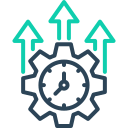Achieving Higher Efficiency in Corporations through Digital Consulting
Start with Clarity: Diagnosing Bottlenecks Before You Digitize
Map the journey from demand to delivery across departments, not silos. In one logistics group, a two-hour workshop exposed nine approval loops hidden in email threads. Streamlining to two visible decision points cut cycle time by 27% within one quarter, without deploying a single new platform.
Start with Clarity: Diagnosing Bottlenecks Before You Digitize
Capture current throughput, rework rates, and lead time distributions before proposing solutions. When one manufacturer quantified variation at each station, the real constraint proved to be handoffs, not machines. Baseline transparency turned political debates into collaborative problem-solving, and unlocked targeted digital fixes with clear payback.



Choose Automation Candidates with Evidence
Target high-volume, rules-based steps with measurable pain. An accounts payable team automated invoice triage after timing every handoff for two weeks. Average processing time dropped from four days to fourteen hours, and exceptions became coaching moments, not chaos. Share your top candidate process—we’ll respond with a quick validation checklist.

Human-in-the-Loop Keeps Quality High
Blend bots and people with clear guardrails. One insurer routed uncertain claims to a specialist queue, capturing learning data to retrain models weekly. Error rates fell by 38%, while customer satisfaction rose. Orchestration beats hype: document who approves, who overrides, and how feedback returns to the system.

Measure Time-to-Value Relentlessly
Track cycle time, rework, and throughput changes from day one, not after rollout. A retail finance team set a 30-day value checkpoint for each automation, pruning low-yield bots early. This disciplined cadence funded the next wave and built credibility. Subscribe for our time-to-value checklist and dashboard template.
Data as an Efficiency Engine, Not an Afterthought
01
Build a Trusted Data Foundation
Create a catalog, enforce lineage, and automate quality checks where data enters. A consumer goods firm added simple validation at intake and halved downstream reconciliation work. Efficiency starts upstream: fix data once, everywhere. Tell us where your data breaks first, and we’ll outline pragmatic first steps.
02
Predictive Insights for Capacity Planning
Use demand signals and machine learning forecasts to schedule staffing and maintenance. A distribution center rebalanced shifts based on weekly predictions, cutting overtime 22% without hurting service levels. When forecasts inform action, efficiency compounds. What would you forecast if your data were reliable tomorrow?
03
Democratize Dashboards, Focus Decisions
Move from wall-of-charts to role-based views that trigger action. Field managers got a simple heatmap highlighting aging orders; escalation times collapsed. Self-service is powerful when curated. Comment with one decision your team makes weekly—we’ll suggest the minimal dashboard that truly helps.
Change That Sticks: Culture, Skills, and Storytelling
Translate KPIs into moments people care about: fewer weekend callouts, smoother handovers, prouder releases. When a CIO framed cycle time as “more family dinners,” adoption surged. Narratives create energy where mandates create resistance. Share how you frame efficiency to your teams—we’ll feature the best phrases.



Sustainable Efficiency: Designing for the Long Run
Create a cross-functional center of excellence that coaches teams, curates standards, and retires outdated practices. A global retailer institutionalized quarterly kaizen sprints and doubled improvement throughput. Make efficiency a product, not a project. Comment if you’d like our COE starter roles and rituals.

